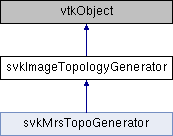|
SIVIC API
0.9.26
|
|
SIVIC API
0.9.26
|
#include <svkImageTopologyGenerator.h>

Public Member Functions | |
| vtkTypeMacro (svkImageTopologyGenerator, vtkObject) | |
| svkImageTopologyGenerator () | |
| ~svkImageTopologyGenerator () | |
| virtual vtkActorCollection * | GenerateVoxelGrid (svkImageData *data) |
| virtual vtkActorCollection * | GenerateSelectionBox (svkImageData *data) |
| virtual void | GenerateVoxelGridActor (svkImageData *data, vtkActor *targetActor) |
| virtual vtkPolyData * | GenerateVoxelGridPolyData (svkImageData *data) |
| virtual vtkActorCollection * | GetTopoActorCollection (svkImageData *data, int actorIndex=0)=0 |
Protected Member Functions | |
| virtual vtkActor * | MakeGridVoxelActor (double *bounds) |
| virtual vtkActor * | MakeRectGridVoxelActor (double *bounds) |
Class that generates topologies for svkImageData objects. Currently it can generate two topology types: a grid that represents the cell structure of a data set and a hexahdron that represents the selection box.
Constructor.
Deconstructor.
|
virtual |
GenerateSelectionBox creates a vtkActorCollection with one element in it, a vtkActor that represents the selection box. This is done by going through the header and pulling out the slabs that represent the selection box. The slabs are split up into two planes each, and placed into a vtkPlanesIntersection object. This object is designed to define any convex region that can be described by a set of boundry planes. Once this region is described the vertecies are extracted, and we use them to create a polyhedron. Right now only a hexaderon is possible, and hence three slabs must be present in the header otherwise NULL is returned.
| data | is a pointer to the svkImageData object whoms selection box you want to represent. |
Referenced by svkMrsTopoGenerator::GetTopoActorCollection().
|
virtual |
Generate the voxel grid. The grid consists of vtkActors that are constructed based on the output of a vtkCubeSource object (can be any reqular hexahedron) which is polyData. The resulting actor collection contains one actor per cell in the data, and each actor will have the same boundries as the cell it represents. The actors are set into the collection in the same order as the vtkID's of the cells in the data set. This means that the id of a cell in the data set is the same as its index in the collection. This fact is important, and is assumed elsewhere (svkPlotGridView, svkOverlayView).
| data | is a pointer to the svkImageData object whoms cell structure you want the grid to represent. |
References svkImageTopologyGenerator::MakeGridVoxelActor().
Referenced by svkMrsTopoGenerator::GetTopoActorCollection().
|
virtual |
References svkImageData::GetDcos(), and svkImageData::SetDcos().
|
virtual |
|
pure virtual |
Implemented in svkMrsTopoGenerator.
|
protectedvirtual |
makeGridVoxelActor generates Actors that represent the spectroscopic voxels. It uses a vtkCubeSource object to generate polydata based on the bounds given to it.
| bounds | a pointer to a length 6 double array representing the bounds of the voxel. (xmin, xmax, ymin, ymax, zmin, zmax) |
Referenced by svkImageTopologyGenerator::GenerateVoxelGrid().
|
protectedvirtual |
makeGridVoxelActor generates Actors that represent the spectroscopic voxels. It uses a vtkCubeSource object to generate polydata based on the bounds given to it.
| bounds | a pointer to a length 6 double array representing the bounds of the voxel. (xmin, xmax, ymin, ymax, zmin, zmax) |
| vtkTypeMacro | ( | svkImageTopologyGenerator | , |
| vtkObject | |||
| ) |
 1.8.5
1.8.5